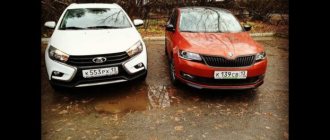Car dimensions
Car interior
Engines Lada Vesta and Kia Rio
Gearbox Lada Vesta and Kia Rio
The domestic novelty has become a serious competitor for foreign car brands. Kia Rio was no exception. This car, together with its compatriot Hyundai Solaris, occupies a leading position in the sales ranking in the B segment on the Russian market. Korean models are rapidly gaining a large number of fans, but the new AvtoVAZ product is not going to give up the laurels of championship. Today we will try to find out which is better Lada Vesta or Kia Rio.
The appearance of the first worthy Russian car cast doubt in the minds of many potential buyers, who now find it difficult to determine what to buy. On the one hand, there is a time-tested Korean authority, and on the other, a bright and dynamic “upstart”. Reviews 2022 and videos shot warmly characterize today's opponents.
“Korean” becomes stronger over time and attracts the attention of the majority. Now this brand commands sincere respect, which it has honestly and conscientiously earned. The Lada Vesta shatters stereotypes, as it was produced at a plant whose work had previously only been depressing and confusing. She is slowly approaching respectability and is ready to take any blow from criticism. It will be difficult to choose, as opinions vary.
Body dimensions
Dimensions of cars First, it is worth comparing the Lada Vesta and Kia Rio in this aspect. The former currently only has a sedan, while the latter also includes a hatchback.
On a note!
The designers and heads of AvtoVAZ diligently promise the appearance of a station wagon and a sports coupe. These achievements will allow the new product to climb to a higher level in competition with foreigners.
- the length of the “Korean” is 4 m 38 cm, the opponent answers 4 m 41 cm;
- the width of the Kia Rio body is determined by the figures 1700 mm, for the Lada Vesta - 1764 mm;
- the domestic sedan also has superiority in height - 1 m 50 cm vs 1 m 47 cm;
- the ground clearance of the Lada Vesta is one of the largest in the class (178 mm), the Kia Rio boasts only 160 cm of ground clearance;
- in luggage compartment volume, the domestic product has an advantage of 10 liters - 480 versus 470;
- Lada Vesta is much heavier - 1230 kg and 1055 kg for Kia Rio. The full load of the first is 1670 kg, the “Korean” holds 1570 kg;
- wheelbase: 2 m 64 cm versus 2 m 57 cm, the product from AvtoVAZ also wins here.
Comparison of Lada Vesta and Kia Rio in terms of appearance
Both models make a pleasant impression, so it is quite difficult to single out a leader in this aspect. The competitors' exteriors are fast and modern, but executed with completely different strokes of the designer's brush.
Car interior
Interesting!
It is absolutely clear that the KIA Rio and Hyundai Solaris are actually twins in technical terms and have the same “parent”. The latter is aimed more at serious people over 35 years old, the first was created with an eye on the young and impulsive generation.
- The entire image of the car is permeated with “flowing” features. The Kia Rio radiator grille is shaped like the nose of a predatory animal, and the narrow optics create the impression of a sly look. The air intake is decorated with a chrome baffle, and buyers also appreciate the fog lights that complement the look.
- Looking at the profile, you notice a slight forward roll. The side panels are framed with stylish stampings. The chrome grabs the window opening without disturbing the mirror and adds some sparkle.
- The rear end completes the look with large and harmonious taillights, a sloping roof and a neatly integrated trunk.
Lada Vesta is not going to give in, as it has a completely memorable image:
- The aggressive and dynamic style consists of classic headlights, a powerful air intake and an equally colorful radiator grille with rare veins of chrome. This exterior attracts people of all ages.
- The wheel rims on the profile side, as well as the “X-style” stampings on the door, define the car as a standard of pressure and courage.
- The back part with its especially large fragments makes you more and more zealously riveted on this dynamic beauty.
Let's sum it up
At a lower price, the Lada VESTA shows much less technical advantages than the KIA Rio. These cars can be classified into the same class. Of course, Vesta is larger and looks more interesting and unusual. But let's compare these cars in a year, and you will understand that the classics always remain attractive. Therefore, the Korean will retain his face throughout the year and will be able to actively attract buyers. But it’s hard to say what will happen to Vesta in a year. Judging by the reviews, during this year of operation you will have to visit the service several times and spend money on repairing problems.
Koreans also have childhood diseases. But KIA gives a good guarantee and corrects all defects for free. AvtoVAZ's warranty conditions are terrible, so you can remove the car from warranty by changing any configuration of the car. The service conditions of the officials are quite complex; sometimes they simply cannot find the cause of a particular problem. It is interesting that when comparing KIA and Lada cars, many do not have any questions about the purchase. They choose a foreign car. But sometimes cost is the most important factor, and then you have to give preference to a cheaper Russian car. Which car would you choose for personal use?
Lada Vesta or Kia Rio: power under the hood
Engines Lada Vesta and Kia Rio Both cars have two types of internal combustion engines. In the near future, as the designers of the Russian plant promise, new modifications of the Lada Vesta model range will be equipped with a high-quality and reliable engine from developers from the Renault-Nissan alliance.
- The first power unit is an internal combustion engine with a power of 107 horsepower and a volume of 1.4 liters. Maximum torque – 135 N/m. The car accelerates to hundreds in 12.5 seconds. The highest speed of a car with such an engine is 170 km/h. Fuel consumption is low: 7.5 liters. In the city and 5.5 on the highway.
- The answer to the Lada Vesta is an internal combustion engine with a power and volume of 106/1.6. This unit accelerates the iron horse to hundreds in 11.8 seconds, and the maximum speed is 178 km/h. The fuel consumption of the domestic product is quite significant: 9 liters in the city, 6.5 on the highway.
- More expensive versions of the Kia Rio are equipped with a 122-horsepower unit with a volume of 1.6 liters. Peak torque is 155 N/m, which allows for a top speed of 180 km/h. Acceleration to hundreds is determined by 10.3 s.
- The powerful 1.8/122 engine of the Lada Vesta has a torque of 170 N/m according to the instrument readings. The engine life will be 200,000 km, and the car can accelerate to 190 km/h. Fuel consumption depends on the type of terrain and gearbox, but remains high.
Salon
The interior design of the Vesta modification SV Cross looks quite stylish. Against this background, Rio doesn't look so good - its interior is downright boring.
Compared to the Lada, the Kia car is more comfortable. Its seats perfectly support the backs of passengers, the only problem is that the seats themselves are a bit short, although they are quite soft. In Vesta, on the contrary, they are excessively rigid, but on the other hand, passengers on the rear sofa are given noticeably more space.
Kia Rio and SV Cross have a common drawback - a low ceiling. Therefore, if a tall person can straighten up, he will cling to the roof with the top of his head.
The good quality of the Kia's interior trim and equipment gives it an edge. Vesta has a lot of disadvantages:
- harsh steering wheel;
- tight buttons;
- Difficult to read instrument dials.
At the same time, the SV Cross steering wheel is easily adjustable both in height and reach. The Korean has more limited functionality.
Vesta has more seat upholstery options. With an overall black color, gray or orange inserts are offered. Here the comparison result is disappointing for Kia - the black tint is diluted only by red. The quality of textiles on the Lada is lower than on its Korean competitor.
What about transmissions?
Lada Vesta uses two five-speed manual transmissions: domestic (VAZ-2180) and French (JH3 510). The basis of the Russian manual transmission is taken from Priora and significantly redesigned with foreign components. Instead of an automatic transmission, Vesta uses a 5-band AMT (robot), which has lower operating and repair costs.
Gearbox Lada Vesta and Kia Rio Kia Rio is equipped with two manual and two automatic gearboxes. The first “mechanics” has 5 stages, the second – six. The Korean transmission works clearly and smoothly. “Korean” “automatic machines” have 4 ranges and 6, respectively. In this aspect, Kia Rio has practically no competitors.
Bumper height
You can drive up to the curb and not hit anywhere. There remains a gap of less than 1 cm.
Whether I did the right thing by selling Vesta and taking Rio, only time will tell. These will be tests in winter, speed measurements. Let's look at Rio's reliability in terms of penetrability of the suspension, the operation of the electrical part, and how much it can be tuned. Let's try to improve the dynamic parameters. I will also try to tell you about this.
Chassis
The suspension designs do not shine with originality and originality; everything here is optimal: there are MacPherson struts in the front, and the body rests on a torsion beam at the rear. The handling of the models is somewhat similar, however, the higher ground clearance of the domestic sedan allows the driver to cope somewhat better with bumpy terrain.
On a note!
The Kia Rio is pleasant to drive, but at high speed the rear end begins to wobble. Manipulating steering is tiring, especially on the highway.
Bottom view
Now let's look at the Kia Rio from below and compare it with the Lada Vesta.
The underbody treatment is a gift from the dealer. Front suspension is MacPherson strut. The exhaust system mounting rubber bands are thick and decent. There are never any problems with them, the corrugation looks interesting.
There are 2 resonators installed, a large muffler, which will not work on Russian cars. It is also suspended by 2 thick elastic bands, which cannot be compared with Vesta.
The condition is still perfect, as the car is still running in and has driven less than 1000 km. The engine guard has cutouts, but you will have to remove it to change the oil. This is what the new 4th generation Rio looks like.
Comparison of interior and prices
There is an assumption that Russian designers were greatly impressed by the Kia Rio interior, which is why the interiors are so similar. They are practically indistinguishable from each other: the center console, the dashboard, encased in plastic, and the steering wheel itself with a special handle. The designers did not forget to install heated seats and glass. Ergonomics and speed of delivery will not make the buyer nervous, and overall visibility increases the chance to better see the purchase of one of the competitors.
Opponents offer a wide range of trim levels to choose from: Lada six, Rio seven. The price of the first is much less than the cost of the second: 515,000 versus 600 thousand rubles. The difference is quite significant for segment B. The maximum price for a “Korean” is 870,000 rubles, the most expensive Vesta can be bought for 660,000 rubles. What to choose: Vesta or Rio - this question can be complicated and will only be resolved after the buyer decides exactly what he wants from the car. Numerous videos and photos can help with this.
Salon
The interior design of the Vesta modification SV Cross looks quite stylish. Against this background, Rio doesn't look so good - its interior is downright boring.
Compared to the Lada, the Kia car is more comfortable. Its seats perfectly support the backs of passengers, the only problem is that the seats themselves are a bit short, although they are quite soft. In Vesta, on the contrary, they are excessively rigid, but on the other hand, passengers on the rear sofa are given noticeably more space.
Kia Rio and SV Cross have a common drawback - a low ceiling. Therefore, if a tall person can straighten up, he will cling to the roof with the top of his head.
The good quality of the Kia's interior trim and equipment gives it an edge. Vesta has a lot of disadvantages:
- harsh steering wheel;
- tight buttons;
- Difficult to read instrument dials.
At the same time, the SV Cross steering wheel is easily adjustable both in height and reach. The Korean has more limited functionality.
Vesta has more seat upholstery options. With an overall black color, gray or orange inserts are offered. Here the comparison result is disappointing for Kia - the black tint is diluted only by red. The quality of textiles on the Lada is lower than on its Korean competitor.











